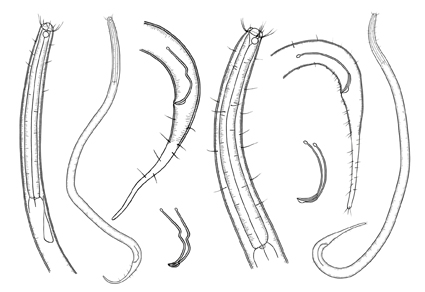Abstract
Two new species of free-living marine nematodes from the littoral sediment of the South China Sea are described as Promonhystera papilla sp. nov. and Promonhystera fluctispicula sp. nov. Both new species are characterized by striated cuticle; circular amphideal fovea; anterior sensilla in two circles, inner labial sensilla setiform; funnel-shaped buccal cavity; elongated spicules and conico-cylindrical tail. P. papilla sp. nov. is different from all known species of the genus by longer body length (more than 2.1mm versus less than 1.5 mm in other species), longer spicules (sp/a.b.d. = 4.1–4.6 versus ≤ 2.7) and males with three papilliform precloacal supplements and one small postcloacal papilla (versus absence) and gubernaculum boot-shaped. P. fluctispicula sp. nov. is similar to P. tricuspidata Wieser, 1956 in having similar waved spicules but differs from the latter species by tail conico-cylindrical (versus conical) and simple plate-like gubernaculum without tooth (versus gubernaculum with four distal teeth).
References
- Chitwood, B.G. (1951) North American marine nematodes. Texas Journal of Science, 3, 627–672.
- Clark, K.R. & Warwick, R.M. (2001) A further biodiversity index applicable to species list: variation in taxonomic distinctness. Marine Ecology Progress Series, 216, 265–278. https://doi.org/10.3354/meps216265
- Filipjev, I.N. (1929) Classification of free-living Nematoda and relations to parasitic forms. Journal of Parasitology Urbana, 15, 281–282.
- Fu, S.J., Boucher, G. & Cai, L.Z. (2017) Two new ovoviviparous species of the family Selachinematidae and Sphaerolaimidae (Nematoda, Chromadorida & Monhysterida) from the northern South China Sea. Zootaxa, 4317 (1), 95–110. https://doi.org/10.11646/zootaxa.4317.1.4
- Fu, S.J., Cai, L.Z., Boucher, G., Cao, J. & Wu, C. (2014) Two new Richtersia species from the northern Beibu Gulf, China. Journal of Natural History, 47, 29–30. https://doi.org/10.1080/00222933.2013.769640
- Fu, S.J., Leduc, D., Rao, Y.Y. & Cai, L.Z. (2019) Three new free-living marine nematode species of Dorylaimopsis (Nematoda: Araeolaimida: Comesomatidae) from the South China Sea and the Chukchi Sea. Zootaxa, 4608 (3), 433–450. https://doi.org/10.11646/zootaxa.4608.3.2
- Heip, C., Vincx, M. & Vranken, G. (1985) The ecology of marine nematodes. Oceanography and Marine Biology, 23, 399–489.
- Hodda, M. (2022) Phylum Nematoda: a classification, catalogue and index of valid genera, with a census of valid species. Zootaxa, 5114 (1), 1–289. https://doi.org/10.11646/zootaxa.5114.1.2
- Hopper, B.E. (1968) Marine nematodes of Canada. I. Prince Edward Island. Canadian Journal of Zoology. 46: 1103–1111. https://doi.org/10.1139/z68-158
- Huang, M. (2021) Taxonomy of Free-living Nematodes from the South China Sea and Molecular Phylogenetic Analysis of the Order Monhysterida. Master’s degree thesis of University of Chinese Academy of Sciences. 221 pp.
- Huang, M., Jia, S.S. & Huang, Y. (2018) One new species and one new record of the species of the family Comesomatidae (Nematoda: Chromadorida) from the South China Sea. Zootaxa, 4504 (1), 119–127. https://doi.org/10.11646/zootaxa.4504.1.6
- Huang, M., Shi, B.Z., Wang, C. & Xu, K.D. (2021). Two new species of nematodes from shallow and deep-water sediments in the South China Sea. Zootaxa, 5016 (4), 490–502. https://doi.org/10.11646/zootaxa.5016.4.2
- Huang, M., Xu, K.D. & Huang, Y. (2019) Setosabatieria minor sp. nov. (Comesomatidae, Nematoda) from the South China Sea. Cahiers de Biologie Marine, 60 (4), 387–393.
- Huang, Y. & Cheng, B. (2012) Three new free-living marine nematode species of the genus Micoletzkyia (Phanodermatidae) from China Sea. Journal of the Marine Biological Association of the United Kingdom, 92 (5), 941–945. https://doi.org/10.1017/S0025315411000476
- Huang, Y. & Wu, X.Q. (2011) Leptolaimus holovachovi sp. nov. (Nematoda) from Shenzhen Mangrove Nature reserve, Shenzhen, South China. Cahiers de Biologie Marine, 52 (2), 147–155. https://doi.org/10.1007/s00343-019-9219-1
- Jia, S.S. & Huang, Y. (2020) Wieseria bicepes sp. nov. (Nematoda: Oxystominidae) from the South China Sea. Zootaxa, 4722 (4), 389–394. https://doi.org/10.11646/zootaxa.4722.4.8
- Lambshead, P.J.D. (2004) Marine nematode biodiversity. In: Chen, Z.X., Chen, S.Y. & Dickson, D.W. (eds.) Nematology: Advances and Perspectives, Vol 1: Nematode Morphology, Physiology and Ecology. CABI, Wallingford, pp. 438–468. https://doi.org/10.1079/9780851996455.0438
- Leduc, D. & Zhao, Z.Q. (2023) The Marine Biota of Aotearoa New Zealand. Ngâ toke o Parumoana: Common free-living Nematoda of Pâuatahanui Inlet, Te-Awarua-o-Porirua Harbour, Wellington. NIWA Biodiversity Memoir, 135, 212.
- McIntyre, A.D. & Warwick, R.M. (1984) Meiofauna techniques. In: Holme, N.A. & McIntyre, A.D. (Eds.), Methods for the Study of Marine Benthos. Blackwell Scientific Publications, Oxford, pp. 217–244.
- Pearse, A.S. (1942) Introduction to parasitology. Bailliere, Tindall & Cox, London, 357 pp.
- Qiao, C.Y., Jia, S.S. & Huang, Y. (2020) Leptolaimus holovachovi sp. nov. (Nematoda) from Shenzhen Mangrove Nature reserve of Shenzhen City, China. Journal of Oceanology and Limnology, 2020, 38 (6),1907–1913. https://doi.org/10.1007/s00343-019-9219-1
- Riemann, F. (1966) Die interstitielle Fauna im Elbe-Aestuar. Verbreitung und Systematik. Archiv Hydrobiologie, Suppl. 31, 1–279.
- Somerfield, P.J. & Warwick, R.M. (1996) Meiofauna in Marine Pollution Monitoring Programmes: a Laboratory Manual. Lowestoft, Ministry of Agriculture, Fisheries and Food, Lowestoft, 71 pp.
- Sun, J., Huang, M. Huang, Y. (2021) Four new species of free-living marine nematode from the sea areas of China. Journal of Oceanology and Limnology, 2021, 39 (4), 12. https://doi.org/10.1007/s00343-020-0195-2
- Venekey, V., Gheller, P.F., Maria, T.F., Brustolin, M.C., Kandratavicius, N., Vieira, D.C., Brito, S., Souza, G.S. & Fonseca, G. (2014) The state of the art of Xyalidae (Nematoda, Monhysterida) with reference to the Brazilian records. Marine Biodiversity, 44, 367–390. https://doi.org/10.1007/s12526-014-0226-3
- Wieser, W. (1956) Free-living marine nematodes III. Axonolaimoidea and Mohysteroidea. Lunds Universitets Årsskrift, 52 (13), 1–115.
- Yu, T.T. & Xu, K.D. (2015) Two new nematodes, Pseudelzalia longiseta gen. nov., sp. nov. and Paramonohystera sinica sp. nov. (Monhysterida: Xyalidae) from sediment in the East China Sea. Journal of Natural History, 49, 509–526. https://doi.org/10.1080/00222933.2014.953224
- Zhai, H.X., Huang, M. & Huang, Y. (2019) A new free-living nematode species of Rhinema Cobb, 1920 from the South China Sea. Journal of Oceanology and Limnology, 38 (2), 545–549. https://doi.org/10.1007/s00343-019-9169-7


